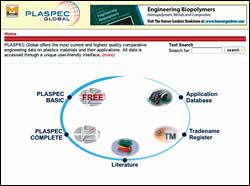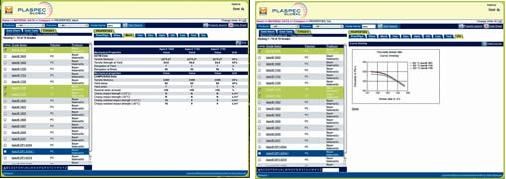Global Materials Database Offers More Data, More Functionality
The Plastics Technology online materials database has a new name, a new look, and lots of new capabilities to help find the right material for a particular job.
The Plastics Technology online materials database has a new name, a new look, and lots of new capabilities to help find the right material for a particular job. Renamed Plaspec Global, the enhanced database is accessible from Plastics Technology’s website (www.ptonline.com/plaspec).
As the name implies, the database has expanded its scope beyond just grades available in North America (which Plastics Technology has offered since 1984) to include materials offered around the globe—you can even select them by geographic availability. This is a result of a partnership with M-Base Engineering & Software GmbH in Aachen, Germany, which developed the software for the worldwide CAMPUS plastics database. Plaspec Global allows users to search among both the CAMPUS data collected by M-Base and Plastics Technology’s non-CAMPUS database.
CAMPUS stands for Computer Aided Materials Preselection by Uniform Standards. It is a consortium started in 1988 by a group of European materials suppliers that developed strict protocols for testing and data reporting in order to ensure a higher degree of comparability between members’ data than can otherwise be assumed for materials data from different sources.
CAMPUS data are now available from 23 firms, 16 of them European, five based in the U.S., and one in Japan. These data are obtained using ISO (International Standards Organization) testing methods and metric units. Users of Plaspec Global can view CAMPUS data converted to English (non-metric) units, just as they can view non-CAMPUS data (typically tested according to ASTM standards) in either metric or English units.
HARD-TO-GET INFORMATION
The CAMPUS section of Plaspec Global includes information not typically available on materials datasheets—such as multi-point curves of properties that change with temperature and/or time, such as creep and creep modulus, viscosity vs. shear rate, shear stress/shear rate, dynamic shear modulus, stress/strain, isochronous stress/strain, and secant modulus/strain. Plaspec Global even lets you overlay such curves for different materials, providing dramatic inter-material comparisons of processability or thermal-mechanical properties.
Other unusual data provided in the CAMPUS database are the conditions under which the “dog-bone” test samples were produced (melt and mold temperature and injection velocity) and special rheological properties needed for inputs to flow-simulation software—such as melt density, thermal diffusivity, specific heat capacity, etc.
MORE NEW FEATURES
Another new addition to Plaspec Global is the Applications Database, which contains hundreds of case studies of materials used in automotive, medical, electrical, packaging, and other industries. These are searchable by polymer type, trade name, industry, and/or part type (e.g., “bumper”). Many of these include photos of the applications and a link to the technical properties of the specific resin used.
Also new is the Tradename Register of resins and additives, searchable by tradename, producer, resin type, or delivery form. Available through the German publisher Carl Hanser Verlag, it identifies the composition of the product, the supplier, and the supplier’s contact information, including web and e-mail links.
One more new feature is the Literature database, which enables you to perform text searches within Plastics Technology’s article archives and Hanser’s International Plastics Handbook. In addition, you can perform a text search across the entire Plaspec Global database. Type text into the search field on the main page and get a list of “hits” or links to relevant content in the materials, applications, literature, or tradename databases.
FREE AND PAID ACCESS
Plaspec Global has two levels of access: Basic and Complete. Basic is free, but requires registration. The Complete version has an introductory subscription price of $99 a year. Even registration for the Basic version provides one-week free access to the Complete functions, so you can determine if you would like to upgrade after seven days.
The Basic version offers access to the full CAMPUS/ISO and ASTM materials database, but with a limited choice of search parameters and ability to print or store single-point and multipoint data on only one material at a time. It also includes access to the plastics Tradename Register and limited access to the Literature Database.
A Complete subscription adds a much wider range of materials search parameters and ability to display, store, and print tables of data on multiple materials. In addition, you can sort the search results by a property of interest and overlay multipoint data curves for up to three resins at a time. The Complete version also provides full access to the Tradename, Literature, and Application databases.
MANY WAYS TO SEARCH
In the Basic version, you can search for materials by supplier, resin type, tradename, melt flow index, flexural modulus, UL 94 flame rating, and processing type. The last two are selectable from dropdown menus and MFI and flex modulus can be specified by minimum and/or maximum levels.
Search results will appear as a list of material grades. Select one at a time to display a complete datasheet with single- and multipoint data (ASTM, CAMPUS/ISO, or both, if available), basic processing information, regional availability, additives (such as mold release or plasticizer), features (such as FDA or USP approved, UV stabilized, antistatic, etc.), and a simple text description of the material and its applications. There are also direct links to the supplier’s website and to the Plastics Technology supplier showroom, which contains information about the company and links to related editorial content on the magazine’s site. Finally, hit the “Print” button to print or download the complete datasheet as an Adobe PDF document.
In the Complete version, several types of searches are possible. The simplest is “Datasheet” mode: Select an individual datasheet—either by scrolling a list of all materials in the database or by specifying polymer, producer, and/or tradename. Each time you select one of these “filters,” you narrow down the list of qualifying materials (the number is displayed on the page). You can view the datasheet on any of the resulting materials by clicking on the grade listing.
You can perform more advanced searches by clicking “Property Search.” This lets you select by geographic region and mechanical, thermal, electrical, and optical properties. For each property, you can specify minimum and/or maximum values. If you click the “Range” button on the right, it will display the range of values for the materials selected so far.
Once you have finished refining your search, you can pick up to three materials on your final list, and the “Compare” function will produce a table of the three materials side by side, with ASTM data (if any) reported separately from CAMPUS/ISO data (if any). You view specific types of data by selecting tabs at the top of the table for processing/physical properties, mechanical, thermal, electrical, optical, and other properties. Each subset of properties can be printed separately, or a PDF datasheet of all the property sets can be printed or downloaded.
In Compare mode, you can also overlay multipoint data curves for up to three selected materials (if the data were available from the supplier). When you click the “Diagram” tab, you will be asked to select the type of curve from a drop-down list. For example, if you select shear rate/viscosity curves, you then may need to select the test temperature(s) you would like to graph for each resin. In the case of stress/strain curves for nylons, you may need to select both temperature(s) and conditioned and/or unconditioned. After your selection, hit “Display” and the composite graph will appear.
If you want to construct a table with more than three grades, click the tab for “Data Table” mode. Use any of the methods discussed above to select all the materials you would like to display. Then use the “Edit Columns” function to choose the specific properties you are interested in displaying. Note that to create a Data Table, you must select materials either from the North American ASTM properties database or the CAMPUS/ISO database, but not both. The table can display only one type of data at a time (unlike the Compare mode). It is against the policies of the CAMPUS consortium to have their data, prepared under strict comparability rules, intermingled with data not conforming to those rules.
The latter point illustrates the attention to “data quality” emphasized by the developers of Plaspec Global. Both Tricia Karsay, product manager of the database at Plastics Technology, and Dr. Erwin Baur, founder and president of M-Base, say quality is more important than mere quantity of data. They are working closely with individual materials suppliers to make sure Plaspec Global has the most complete and up-to-date materials listings without duplications or obsolete grades. They say this principle will also guide future database enhancements planned for release in coming months.
Read Next
Beyond Prototypes: 8 Ways the Plastics Industry Is Using 3D Printing
Plastics processors are finding applications for 3D printing around the plant and across the supply chain. Here are 8 examples to look for at NPE2024.
Read MorePeople 4.0 – How to Get Buy-In from Your Staff for Industry 4.0 Systems
Implementing a production monitoring system as the foundation of a ‘smart factory’ is about integrating people with new technology as much as it is about integrating machines and computers. Here are tips from a company that has gone through the process.
Read MoreSee Recyclers Close the Loop on Trade Show Production Scrap at NPE2024
A collaboration between show organizer PLASTICS, recycler CPR and size reduction experts WEIMA and Conair recovered and recycled all production scrap at NPE2024.
Read More





























